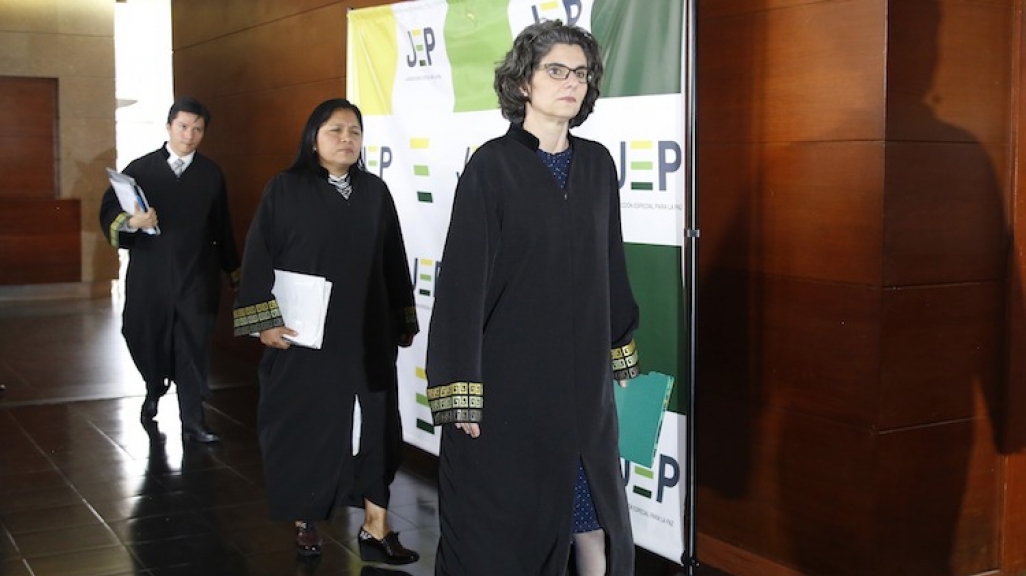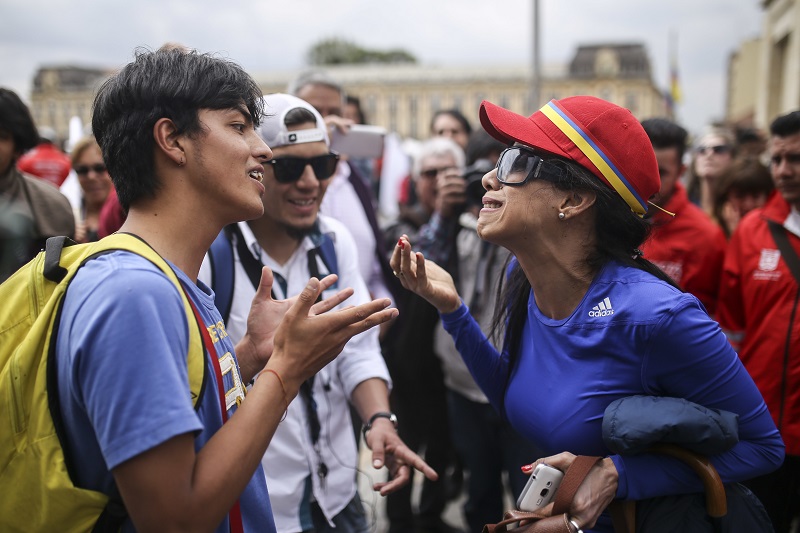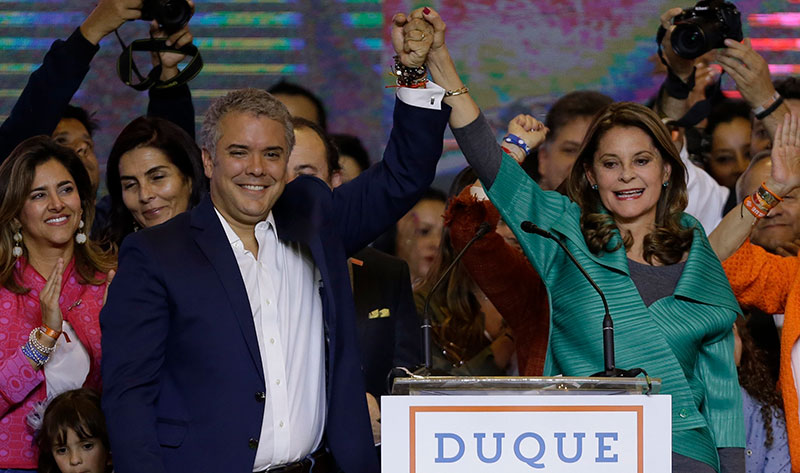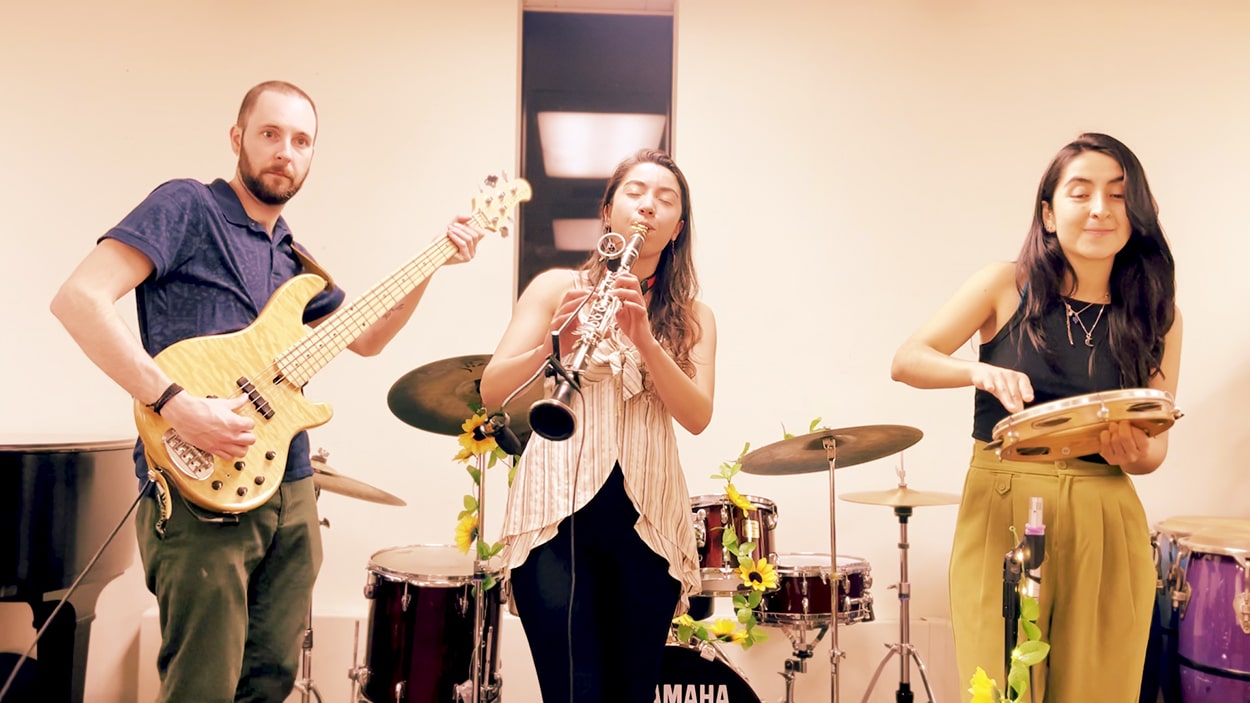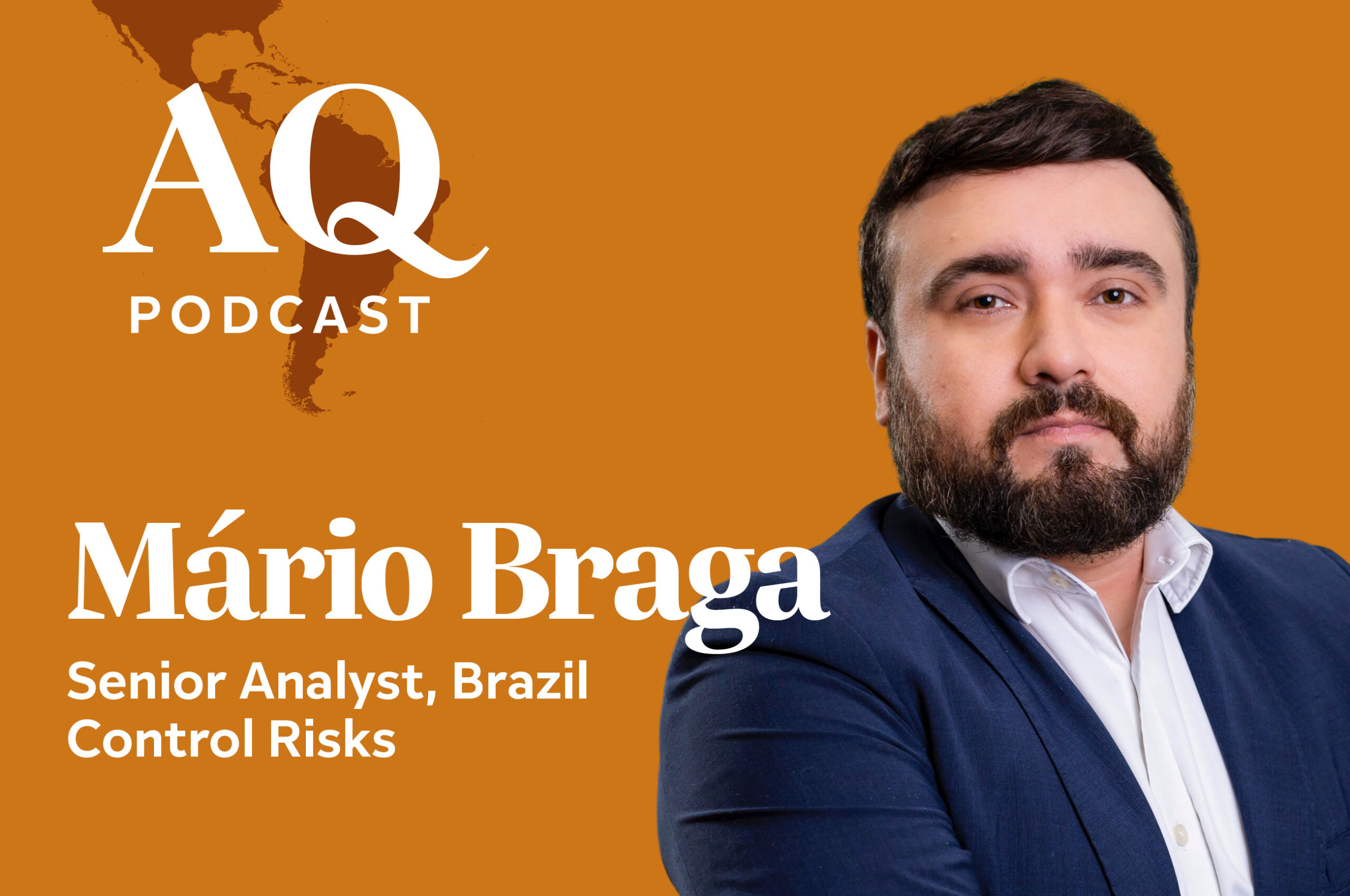Explainer: Colombia's Special Jurisdiction for Peace (JEP)
Explainer: Colombia's Special Jurisdiction for Peace (JEP)
The issue of how former FARC guerrillas face justice under the extrajudicial JEP court system continues to dominate and divide Colombia.
Twenty months after a landmark peace agreement with the Revolutionary Armed Forces of Colombia passed the country’s Congress, the implementation of peace remains fragile. One of the issues at the heart of it all is a newly installed extrajudicial court system to try ex-rebels and others for their various crimes during more than five decades of armed conflict.
The system is known as the Special Jurisdiction for Peace (JEP). Negotiators from the Juan Manuel Santos government and the FARC, as the guerrilla group (now converted into a political party) is known, developed the JEP structure as part of a landmark September 2015 agreement on transitional justice. The ideology behind transitional justice is notably not punitive but restorative, meaning that it aims to put victims of the conflict front and center and can include reparations for them, a commitment to truth, acknowledgment of perpetrators’ culpability, and prevention of future violence. Those who are tried via the JEP typically can receive lighter sentences than they would under ordinary law, and in some cases have smaller crimes pardoned. The crux of the debate around the JEP and transitional justice is if this structure does indeed provide justice, and if it is in line with Colombian and international law.
We look at the steps Colombia took to arrive at transitional justice, how the JEP is designed, and the latest developments in the court, which held its first hearing on July 13 when Rodrigo “Timochenko” Lodoño, along with two other FARC bosses, began to give testimony of his involvement in kidnappings.
- Past experience informs the present
- The public debate
- Transitional justice in the FARC agreement
- How is the court structured and who are the judges?
- Who can be tried via the JEP?
- Types of crimes and sentences
- Extradition and political participation
- The new president and Congress
Past experience informs the present
The Santos administration was not the first administration to try and implement a system of transitional justice for ex-rebels. From Belisario Betancur to Álvaro Uribe, past presidents’ attempts to make peace with other left-wing guerrilla groups, right-wing paramilitaries, and others had a mixed bag of results. Those experiences frequently informed Santos’ administration and FARC negotiators, who spent four years meting out an agreement in Havana.
Of all the presidents before, Uribe got the farthest. In 2003, he signed a peace agreement with the paramilitary organization Autodefensas Unidas de Colombia (AUC), whose members then began the process of demobilization. Then in 2005, Uribe signed a law that set terms for the disarmament, demobilization, and social reincorporation of paramilitary fighters involved in the war with FARC, incorporating transitional justice precepts absent from previous measures and granting amnesty to paramilitary combatants. More than 31,000 AUC members demobilized in 2006. Some politicians, meanwhile, claimed that ordinary criminals and drug traffickers were passing as AUC members in order to receive the preferred terms of the group’s transitional justice deal. (With this experience in mind, verification of who were confirmed FARC members comes up regularly in their process.) Additionally, during the original peace talks, Uribe denied an extradition petition from the United States requiring 14 AUC bosses to face drug smuggling charges. In 2008, however, the Uribe government decreed that these paramilitary heads had not complied with the peace agreement and opted to follow through with the extradition.
By Santos’ own account, transitional justice was “the most complex, most difficult issue” of the entire peace process, holding up negotiations for months at a time. “Transitional justice was the most contentious issue of the peace process,” Ana María Ibáñez, an expert in the economic effects of internal conflict and a dean at the Universidad de los Andes, said in an email to AS/COA Online when the agreement was signed. “The FARC were not willing to be prosecuted and a large percentage of Colombian society was not willing to forgive the crimes that the FARC has committed [during] more than 50 years of operation.”
Most critically, one year after the transitional justice agreement and a mere six days after the two sides signed the peace deal as a whole in a ceremony in Cartagena, voters narrowly rejected the peace deal in a nationwide plebiscite. The “No” campaign against the deal, led by Uribe, argued that ex-guerrillas were receiving “impunity” and political power—notably 10 seats in the next two Congresses—without sacrificing anything in return. While much of the international community supported the peace deal, José Miguel Vivanco of Human Rights Watch was (and remains) a persistent critic of the agreement, which he says, among other things, is vague in defining punishments for war criminals, as well as FARC and military leaders’ liability for their subordinates’ actions, possibly in violation of international law. Amnesty International also said the agreement fell short of international standards on law and human rights.
A revised deal, with some concessions to the “No” camp, passed Colombia’s Congress in November 2016. Congress spent much of 2017 debating how various points of the JEP, among other parts of the agreement, would be codified into the country’s Constitution and legal structure. In October of that year, the country’s Constitutional Court issued a ruling that the country’s next three presidential administrations must comply with the agreement, though the executive and legislature are still understood to have considerable discretion over how the deal is implemented. The JEP officially opened for business in March 2018. That same month, Uribe’s Democratic Center party won legislative elections to become the largest party in the Colombian Congress for the 2018–2022 session, and his protégé Iván Duque won the presidency in June.
Transitional justice in the FARC agreement
The peace agreement had six main pillars of negotiation: rural agrarian development, political participation, drug trafficking, victims’ rights, disarmament and demobilization, and post-agreement monitoring and verification. Transitional justice was located under the umbrella of victims’ rights, hence the focus on them and restorative justice.
To ensure victims’ representation, negotiations included public forums and testimony from social groups and other members of Colombian society, including 60 individuals who traveled to Havana to give their personal accounts to FARC and government representatives. The agreement gives primacy to victims identified as particularly vulnerable, especially women and children. Despite efforts to include victims’ voices in the process, some argued that refugees, internally displaced persons, and other survivors were insufficiently involved in determining the framework for peace and transitional justice.
The JEP is technically part of a body known as the Comprehensive System for Truth, Justice, Reparation, and Non-Repetition, or SIVJRNR by its Spanish initials. Also under the SIVJRNR are a truth commission, a disappeared persons search unit, and a verification body.
How is the court structured and who are the judges?
There are six main bodies of the JEP: the main Peace Tribunal, three smaller chambers, and two separate offices. A cooperating defendant will see his or her case move through the three chambers in succession, with the Peace Tribunal overseeing the process as a whole. The first is the Truth and Reconciliation Chamber, in which defendants have the opportunity to confess to their victims. Next, the defendant passes to the Amnesty and Pardon Chamber, where judges will decide what crimes qualify for pardon and for which ones the defendant will receive a sentence. Finally, the defendant’s case moves to the Sentencing Chamber. If a defendant does not acknowledge his or her crimes, on the other hand, the JEP’s Investigative Unit will take up the case and review evidence to see if there is an indictment to be brought. Investigative Unit prosecutors will then present their findings to the Peace Tribunal, which will then remand the case to one of the three chambers in the process. Lastly, there is also the Office of Executive President, currently headed by acting JEP President Marta Lucía Zamora, a former solicitor general, after the original president resigned in May.
There are 38 judges sitting on JEP benches, of whom 20 are women, four come from indigenous communities, and another four Afro-Colombian ones. The court also counts 13 supplementary judges (seven women, six men), along with 14 non-voting foreign magistrates who sit on the benches as amicus curiae, or friends of the court. Six Colombian judges sit on each of the three chambers’ benches, and the other 20 on the Peace Tribunal. At least 16 prosecutors serve in the Investigative Unit.
The biggest group of defendants will be former FARC guerrillas, specifically a list of 7,000 names the rebels turned in when they began the disarmament process in December 2016. Close to 5,000 ex-fighters have already submitted confessions to the court for review. Members of right-wing paramilitary groups can also be tried for their crimes committed during the armed conflict. Civilians and public officials, if they benefitted or cooperated with the guerrillas in some way, can voluntarily submit themselves to the JEP but they cannot be indicted by the state.
Members of the Armed Forces and public security who are implicated in crimes—most notoriously the “false positives” scandal in which citizens were killed and their deaths passed off as FARC losses—can also be prosecuted via the JEP. The Defense Ministry turned in a list to the JEP of 1,944 Armed Forces members to be investigated for crimes, of whom 90 percent were involved in “deaths presented illegitimately as combat deaths.” On July 10, for the first time ever, a Colombian army general issued an apology for his alleged participation in the false positives scandal, and two weeks later, the JEP opened an investigation into the deaths of the 2,248 known victims, which peaked during the latter years of Uribe’s administration (2002–2008). (According to Human Rights Watch, Army units killed at least 3,000 civilians during Uribe’s two terms.)
The modus operandi of the JEP sentencing could be summed up as such: “The more you cooperate, the easier this will go.” There are two main criteria that determine the accused’s sentence: 1) if he or she participated in serious crimes or not, 2) and if he or she readily admits and takes responsibility for his or her crimes up front.
Serious crimes against humanity include genocide and extrajudicial killings, forced disappearances, kidnapping, and torture. The government has identified more than 8 million victims of the conflict in the country of 48 million people. While the vast majority are those who have been forcibly displaced from their homes, this figure also includes 983,000 homicides, 166,000 disappeared persons, 35,000 kidnappings, and 10,000 cases of torture.
If the accused admits to his or her crimes up front, he or she will serve between five to eight years of an alternative sentence that deprives them of various personal liberties if the crime is serious, and between two to five years if the crime is not. Alternative sentences can include house arrest and/or community service, to be meted out in agreement with the victim(s), to whom they might also owe reparations. Reparations included the removal of mines and explosives from territories in which FARC had operated, finding, identifying, and returning the remains of people who went missing during the conflict, new judicial mechanisms to break apart criminal organizations, and the restitution of land titles.
That said, the defendant could spend their sentence in a regular prison if he or she doesn’t fess up to crimes initially but only does so after a criminal investigation. Finally, if the accused refuses to take responsibility for any crime and is later found guilty by the court, he or she faces a sentence of 15 to 20 years in a regular prison.
If the defendant is found to be guilty only of political crimes (e.g. adhesion to the FARC’s political ideology and rebellion against the state) or illegal weapons possessions, on the other hand, he or she is eligible to receive a pardon for those crimes.
Extradition and political participation
As set in the revised peace agreement signed by the Santos government and the FARC, former rebels are shielded from extradition for crimes committed during the 52 years of armed conflict up until the revised peace agreement went into effect on December 1, 2016. But, if someone commits a crime after that date, the terms of the agreement don’t apply and they are prosecuted under ordinary Colombian criminal law and thus subject to extradition. Meanwhile, those tried by the JEP can participate in politics as long as they’re only serving alternative sentences and not found guilty under ordinary criminal law.
The case of top FARC commander Seuxis Hernández, known more commonly as Jesús Santrich, is bringing this point in particular to a head. Colombian authorities arrested Santrich in April 2018 on an Interpol warrant after U.S. DEA officials charged him with conspiracy to traffic 10 tons of cocaine worth $320 million into the United States. But before he can be extradited, a Colombian prosecutor must prove that Santrich committed these crimes after December 1, 2016. It’s presented the first serious case of the complexity of two justice systems running side-by-side and has made plain the fragility of all parties’ trust in each other and the process as a whole. If his case moves instead to the JEP, Santrich and fellow rebel negotiator Iván Márquez are each supposed to take one of the FARC’s 10 guaranteed seats in Congress, Santrich in the House and Márquez in the Senate.
The new president and Congress
Duque takes office on August 7. The one-term senator, 42, won the presidential runoff after a campaign in which he regularly promised to reform the peace agreement to enact harsher penalties on former FARC combatants. “The Special Jurisdiction for Peace is an impunity mechanism that makes the perpetrators of crimes against humanity eligible for politics,” he said in January. “This is a mockery and an affront to their victims and to our rule of law.” Duque could undermine its implementation by, for example, withholding funds from government agencies created to implement the accord.
Following Duque’s victory, Colombia’s House of Representatives voted to enact JEP’s procedural norms. Meanwhile Duque’s Senate allies, led by Uribe, voted to form a separate tribunal for security force crimes—where some argue they could receive even more lenient sentences than under the JEP terms—and delay investigations into the military by 18 months. The measure also would restrict JEP judges from asking for evidence of when crimes were committed (i.e. before or after December 1, 2016), and therefore if the defendant is subject to ordinary justice and extradition or can stay under the JEP’s jurisdiction. FARC leaders have asked the Constitutional Court to rule this as unconstitutional and a violation of the agreement. In late July, Uribe resigned his Senate seat amid an investigation into his own alleged implication in paramilitary atrocities during the conflict, only to withdraw his resignation days later. The Supreme Court is reviewing his case, as he is an elected official.
The peace agreement provides for the court to be in operation for 15 years, with the option to extend for five more years. Nestor Raul Correa, the tribunal’s original executive, estimated the court would only be able to investigate 1,000 of some 200,000 crimes committed over 50 years. “Transitional justice, by definition, is modest,” he said in March, “because we already know we can’t do everything.”






